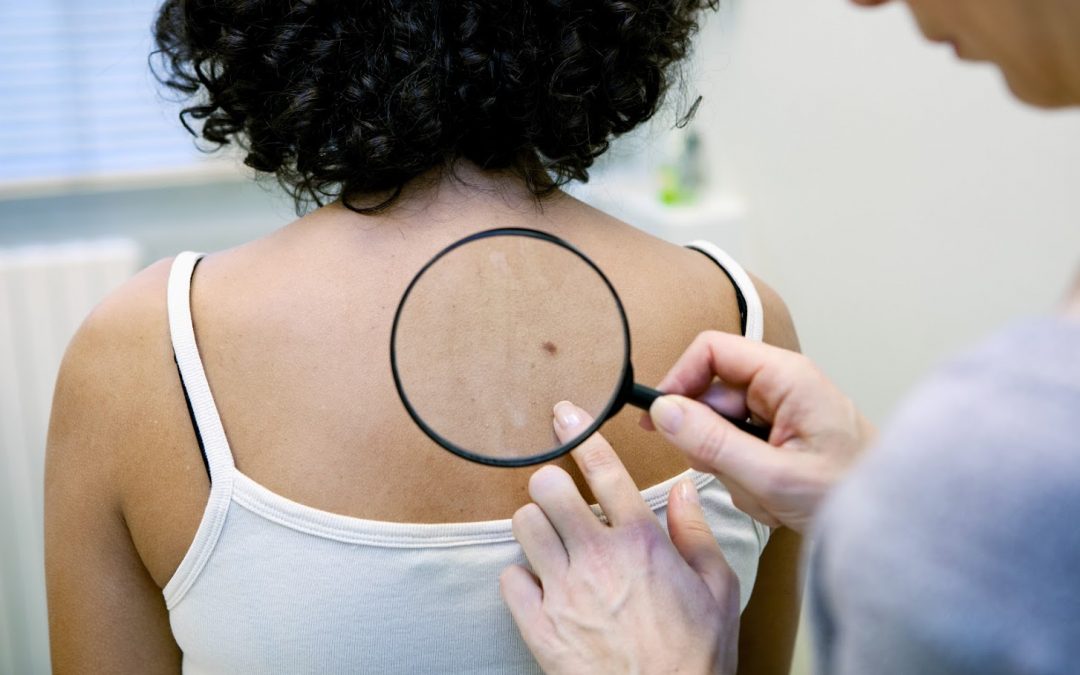Did you know that about 1 in 100 people are born with a mole somewhere on their skin? Did you also know that most adults have anywhere from 10 to 40 skin moles? Because moles are quite common, some people might not realize how moles can provide important information about skin health. What exactly are skin moles and when is the time right to remove them?
What Are Skin Moles?
Moles are benign growths on the skin that are usually brown or black and can appear anywhere on the skin. They can be flat or raised, and most moles are less than a quarter-inch in size. While moles are generally harmless, they can sometimes become cancerous.
You might think that a skin mole is similar to a freckle. While they are both dark spots on the skin that appear because of skin cells with extra pigment, the two spots are quite different. Some of these differences include:
- Freckles are flat on the skin while moles are raised.
- Freckles typically are not as dark as moles.
- Freckles tend to appear darker after sun exposure.
The most important difference between freckles and skin moles is that freckles do not have any potential to become cancerous. For this reason, if you have both freckles and moles, you do not have to worry about your freckles but you should pay attention to your moles.
What Causes Freckles
Freckles are caused by a genetic tendency to produce more melanin, the pigment that gives skin its color. When skin is exposed to the sun, freckles will become darker.
What Causes Moles
Moles are caused by a genetic tendency to produce melanin, the pigment that gives skin its color. However, moles can also be caused by sun exposure. When skin is repeatedly exposed to the sun, it can cause moles to become darker or even raised.
Do Different Kinds of Skin Moles Exist?
You acquire a skin mole, also known as a nevus, in one of two ways. Moles are either congenital, meaning you had them when you were born, or they naturally develop on the skin because of sun exposure and age. All skin moles are either common or atypical.
Common moles usually develop because of sun exposure and measure between 5 to 6 mm. The edges of a common mole are usually distinct and smooth.
Atypical moles, on the other hand, are generally larger than other moles and have fuzzy borders. Skin moles can turn into a type of skin cancer called melanoma, which is why you need to pay attention to the moles on your body. You should also be especially cognizant of any new skin moles, as new moles present a higher risk of being cancerous.
The presence of a large number of atypical moles can also increase the chances of getting skin cancer. You can find moles on any part of the skin, including places like on the bottom of the feet, the palms of the hands, and even on the eyelids. For women, some of the most common parts of the skin that melanoma occurs includes the arms and the legs.
Men on the other hand, typically get skin cancer on the head, neck, back, and trunk. Because of this, men and women should pay especially close attention to moles on these particular parts of the body.
What Is the ABCDE Method?
Both common and atypical moles can change over time. This means they can get larger, smaller, darker, lighter, or they might disappear altogether. Skin moles also grow hair. So how do you know when you should be concerned about your moles? Many health professionals recommend using the ABCDE method to check your moles:
- Asymmetry: Half of the mole does not look like the other half.
- Border: The mole’s border becomes undefined.
- Color: The mole contains more than one color.
- Diameter: The mole has become larger than 6 mm.
- Evolution: The mole constantly changes.
If you notice any of these characteristics, you should have a dermatologist check out the mole. You should also have a medical professional check the mole if it starts to itch, bleed, or becomes bothersome in any way. However, just because a mole contains any of the above characteristics, this does not automatically mean you have skin cancer.
When Should You Remove a Mole?
Melanoma is one of the most common types of cancers in the United States. If you are concerned about getting melanoma, you may want to remove an abnormal mole right away. This is especially true if you have any of the following risk factors that increase your chances of getting melanoma:
- You have fair skin that freckles or burns easily.
- You have had one or more severe sunburns.
- You have a family history of skin cancer.
- You have undergone an organ transplant or have a weakened immune system.
- The mole changes size
- The mole changes shape
- The color of the mole changes
- It becomes itchy
- It starts bleeding or oozing
One more factor that can increase your chances of getting melanoma is having had excessive exposure to UV light, which is commonly in tanning beds.
How Does a Medical Professional Remove a Mole?
Mole removal is a surgical procedure. Two of the most common methods used to remove a mole include cutting it out or using a scalpel blade. The method used largely depends on the depth of the mole and the cosmetic outcome that the patient desires. When the mole is cut out, stitches may or may not be necessary. With either method, the patient requires a local anesthetic.
A less common method of mole removal is electrodesiccation and curettage. In this procedure, a medical professional uses an electric current to destroy the mole. Then, the area is curetted, or scraped clean, to remove any remaining tissue. This method is often used on moles that are located in sensitive areas, such as the face. It is also used on moles that are difficult to remove with other methods.
Lastly, a medical professional may use a laser to remove a mole. This method is often used on moles that are located in difficult-to-reach places or on moles that have been previously removed. A laser removes the mole by burning it off. This method is often used on moles that are melanoma, or cancerous.
When a medical professional removes a mole, he or she takes into account the patient’s cosmetic desires, the location of the mole, and the depth of the mole. If you have a mole that you would like removed, it is important to speak with your doctor about the best method for you.
Remove Skin Moles in Nashville, Tennessee
If you need mole removal surgery, call The Surgical Clinic today to book your appointment. We are also happy to answer all your questions.

